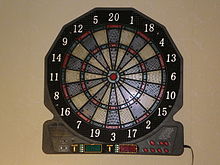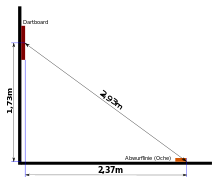darts
Darts , also known as darts (South German Spicken / Spicker / Spickern ), is a game of skill and a precision sport in which arrows (the darts, South German Spickern ) are thrown at a round disc (the dartboard).
Emergence
There are many assumptions about the origin of darts that deal with numerous possibilities. 19th century records suggest that England is the motherland of darts.
The name, however, comes from French. The French used small spear-like darts as weapons in battles - the darts. This French weapon was also known in England. Allegedly Anne Boleyn gave her husband Henry VIII a set of these arrows. Despite its origins, the game is called Les fléchettes in France .
After Keith Turner, the darts are the youngest arrow-like weapons. They emerged after his research 2,400 years ago. The bow and arrow were first used 30,000 years ago, and javelins were used 400,000 years ago.
As plumbata , small darts weighted with lead weights and barbed arrows were used in war by the Romans .
The sport of darts probably originated between 1860 and 1898. In the last year mentioned, an American patented the first paper flights developed for darts (wings at the end of the shaft to stabilize flight behavior). The first sporting competitions took place in Great Britain in the early 20th century.
In 1896 the English carpenter Brian Gamlin laid down the division of the dartboards. In 1898, paper wings replaced the turkey feathers that had been used until then. In 1901 the first known ad about dartboards appeared in the Stationer, Printer & Fancy Trades Register . In 1902, a local Lancaster newspaper reported the first dart throws with the highest score of 180 points. In 1906 the previously wooden dart body was replaced by metal in Yorkshire .
In 1908 the game of darts was declared a game of skill with the result that it could now be played in pubs. It is reported that innkeeper Jim Garside , owner of the Adelphi Inn, Leeds , was charged with betting on a game of chance (namely darts). During the trial against him, he went on the offensive with the help of the best dart player in the area, William "Bigfoot" Anakin. A dartboard was hung in the courtroom and William Bigfoot Anakin proved his marksmanship to the court by hitting the 20 three times. A bailiff trying to emulate him hit the target with just an arrow. Whereupon Anakin increased the demonstration of his marksmanship again by hitting two times 20 three times. The judges were impressed by so much skill and gave the verdict: This is no game of chance - this is not a game of chance .
dartboard
Similar to archery, the origin of the dartboard lies with the wagon wheels. These were used for target shooting in England in the 12th century. Later, special values were assigned to the distances between certain spokes, while the hit in the hub ( bull's eye ) always had the highest value. The dartboard is divided into 20 segments with a value of 1 to 20 and the center point Single Bull (green) = 25 and Bull's Eye (red) = 50 points.
The segments are distributed around the center point (clockwise, starting at 12 o'clock) as follows:
20 - 1 - 18 - 4 - 13 - 6 - 10 - 15 - 2 - 17 - 3 - 19 - 7 - 16 - 8 - 11 - 14 - 9 - 12 - 5.
This order was established in 1896 by the English carpenter Brian Gamlin and was probably intended to punish inaccuracy and limit the element of chance. The numbers are arranged so that they require marksmanship. That is why there are mostly single-digit numbers in addition to two-digit numbers (for example 20 between 1 and 5).
The center of the disc is divided into two different fields. The outer ring, the bull (also: outer bull or single bull, green) counts 25 points. The inner circle, the bull's eye (also inner bull or double bull, red), counts 50 points. In the double-out variant, the bull's eye can be used to end a leg (or at the start of the game with a double-in ) because it counts as a double field.
The inner narrow ring is the triple (in English also treble). If an arrow hits this area, the value of the field triples. The outer narrow ring ( double ) doubles the score.
Contrary to many beginners' opinions, the bull's eye, i.e. the middle of the board, does not get the most points, but the triple 20. Since the value of the 20 is tripled, a total of 60 points are achieved when the triple 20 is hit.
The player stands behind the throw line ( Oche on) to throw arrows at the target.
The steel dart board consists of sisal fibers , which are sometimes referred to as pig bristles , but which means the African sisal fibers and not pig hair. Inexpensive discs are made from cork or paper .
The segments are separated by a mesh of wire along the segment boundaries. This wire construction is called a spider.
Dimensions
- The height to the center of the dartboard is 1.73 m above the ground (1.72 m according to the DSAB - German Sports Association)
- The horizontal distance from the throwing line (oche) to the target is 2.37 m (2.44 m for soft darts until the end of 2015).
- The American League Dart indicates a distance range: between 7 feet 9 1 / 4 -inch (2.37 m) and 8 feet (2.44 m).
- The diagonal dimension (distance from the bull directly to the oche) is 2.93 m.
- Lateral distance between the middle of the pane and the wall at least 0.90 m, between two panes at least 1.80 m
- The free space behind the throw line should be 1.25 m.
Dimensions of the dartboard
According to the sports and competition regulations of the German Darts Association:
- Double and triple ring (inner dimension) 8.0 mm
- Diameter of the double bull (internal dimension) 12.7 mm
- Size of the entire bull (internal dimension) 31.8 mm
- Distance from the outer double wire to the bull 170.0 mm
- Distance from the outer triple wire to the Bull 107.0 mm
- Distance from one outer double wire to the opposite outer double wire 340.0 mm
- Wire diameter: 16–18 SWG (corresponds to approximately 1.2 to 1.6 mm)
darts
Each player has three arrows called darts. Darts consist of a tip, the barrel , the shaft (engl. Shaft ) and a Flight . The latter are narrow wings or leaves that keep the dart on course. There are two types of darts: steel and soft darts.
Structure of a dart
- Tip or Point: There are different types of points, made of plastic ("Soft") or steel ("Steel"). There can also be screw-on steel tips for soft darts, conversion points . Steel tips are available in various lengths and designs. Steelpoints should generally not be pointed, but rounded. This prevents the boards from wearing out too quickly and the darts hang better and more stable in the board, which can lead to higher scores.
- Barrel: Here is between "Brass" ( brass ), "Tungsten" ( tungsten ) and " Nickel distinguished". With tungsten barrels, the tungsten content is given in percent; the higher the percentage, the thinner the barrel can be made with the same weight, which enables a closer grouping on the board. Barrels come in a variety of shapes and weights. Movable tips (Powerpoint, Hammerhead) are also available, which are supposed to reduce bouncers (ricochets). Movable tips only fit into barrels made for this purpose, as they require a particularly deep thread. In addition to the normal barrels, there are M3 barrels in which the thread is on the outside, so the barrel can be made even thinner if the weight is higher. There are special shafts and tips for M3 barrels.
- O-ring: it is a small rubber ring that is placed on the thread of shafts made of aluminum or carbon fiber reinforced plastic and prevents the shafts from loosening while playing and thus reducing the stability of the darts. There is no need for O-rings with nylon adhesive, as they usually do not come off. At first there was a kind of screw locking agent ("Loctite") from various manufacturers, which was supposed to prevent the shafts from coming loose, but it has now disappeared from the market.
- Shaft: Shafts come in many variations. The most widespread are polyamide (“nylon”) and aluminum adhesives, sometimes shafts made of carbon fiber reinforced plastic. The length of the shaft is important when putting it together, mini (thumbnails), x-short, short, medium and long are available.
- Collar: these are only used with nylon shafts. There are three different types, the purpose is always the same. Collars should compress the end of the nylon shaft and thus connect the flight firmly to the shaft. The collar prevents the shaft from being damaged if a subsequent dart hits the back. The most suitable are the resilient rings, as they "modulate" the shaft back to its original shape in every situation, while fixed rings burst or lose their shape after a while.
- Flight: The last part of the darts is the flight. Flights are primarily made of polyester or nylon. The most important thing about flight is its shape. Standard flights are used by most players. The area information is only for orientation, flights with the larger area do not necessarily have more lift, this is due to the short distance a dart has to cover. Kite flights come closer to the standards than slim flights, although they have a smaller area. The firmer or thicker the flights are, the better its trajectory will be. The dart does not go into a tailspin that quickly and such flights also offer a longer lifespan. Fabric flights are the most durable, these are only recommended with nylon shafts. With aluminum shafts it is very difficult to mount such a flight without damaging it. As soon as a flight has too many kinks or cracks and nicks, it should be replaced.
- Protector: It is placed on the end of the flight to protect it from the subsequent darts. The closer you throw the darts, the more often it happens that the next dart hits the first one and thus ruins the flight and, in the case of aluminum, the shaft. The protector ricochets off the dart and usually lands in the board anyway without causing any major damage. Protectors are made in aluminum and nylon. In addition, the flight remains nicely spread.
Steeldarts
Steeldarts have a metal tip and a length of up to 30.5 cm with a weight of up to 50 g. The barrel usually consists of a nickel - tungsten - alloy which allows a high weight in a narrow Dartkörper. For a throw to be counted, the dart must remain stuck in the dartboard until it is pulled out by the player. In the case of steel darts, a scorer (writer) is required, who notes the points thrown on a board and calculates the current remaining score. The player himself should also have a certain routine in arithmetic so that he always knows exactly what to throw next in order to bring the game to the fastest possible end. There are also out-charts for this , a list of different scores and the possibility of setting these to 0 with two or three darts. Example: 120 points remainder = T20 20 D20 (Triple 20 ( 60 ) + 20 + Double 20 ( 40 ) = 120 ). Steeldarts games start with 501 points in a single, 701 or even 1001 in a team. Each game must end with a double field.
Soft darts
- In the automatic darts, also known as electronic darts (e-darts), the darts have a plastic tip, their weight is limited to 21 g (18 g until 2019), as otherwise the machine could be damaged - the total length may be 16 , Do not exceed 8 cm. The points of the throw count as soon as the machine has registered them. Most machines can handle a variety of games, from the common variants 301 and 501 to 701 (each with the additions Double In , Double Out or Masters Out ), as well as cricket in various variants up to the more exotic games such as elimination .
Game variants
301/501
This game variant is the basis for tournament games.
Each player has 301 or 501 points. The players take turns throwing their three arrows at the disc. The points achieved by the player are subtracted from the 301 or 501 points. Whoever reaches exactly zero points first has won. If a player throws more points in a round than the remaining points, his throws for that round are invalid. This is called the bust rule (throwing over).
To finish, the score must always be reduced to exactly zero. There are several game variations to end the game, the most common of which is Double Out . In the case of Master- and Double-Out , a throw that leaves a score of one point as the remainder is already considered thrown over and is not counted (since the next and last throw must count at least two points, namely the double field of the 1).
The game variants are:
- Straight Out : any field can be hit to finish.
- Double Out : a double field must be hit to end.
- Master Out : like Double Out , but can also be ended with a throw in a triple field.
- Double In : at the beginning of the game, any double field must be hit, only from then on do the thrown points count (including the thrown doubles).
- Triple In : At the beginning of the game, any triple field must be hit, only from then on do the thrown points count (including the thrown triplet).
All game variants can also be played as 701 on many machines. If at the end of the game the loser has not yet reached a remaining number of points from which he could end the game with three darts, this is sometimes called a tailor . Completing a 501 game with the minimum number of 9 darts is a nine dart finish . The earliest possible score for checkout with a 3-dart finish is exactly 170 points in a 501 game (with "double out"). Here the player can complete the game with Triple 20, Triple 20 and the Bulls Eye. (For "Straight Out" or "Master Out" it is 180 points, achievable by Triple 20 Triple 20 Triple 20 / Triple 20 Triple 20 Triple 7 / Triple 20 Triple 20 Triple 20). With a score of 170 points there are different ways to end the game with a 3-dart or 2-dart finish.
There are variants of 301 and 501 with different scores such as 180, 401, 601, 701, 801, 901 and 1001. Variants 701 and 1001 are used in tournament games.
Tactics / Cricket / Mickey Mouse
In tactics , cricket or Mickey Mouse , the numbers from 20 to 10 (regionally, sometimes up to 11 is played; in e-darts 20 to 15) and bull must be hit three times. The outer ring of the bull (single bull) counts once, the inner field (bullseye) counts twice or as a double. If a field has already been hit three times and is hit again, the corresponding points are credited, provided the opponent has not hit this field three times. The winner is the one who is the first to hit all of the named fields three times and has the most points. A single means one hit, a double means two hits and a triple is counted as three hits.
There are also the variants Chance it (the machine randomly selects the 6 numbers) and You Pick It (players choose the 6 numbers), which must be hit by all players.
Cricket can also be played in conjunction with the Cut Throat option . The points that come on one of the numbers to be hit after they have been hit three times before (or - in the case of a double or triple hit - also with this throw) are not assigned to the throwing player himself, but to all other players, who have not hit the corresponding field three times. As a result, the player who first hits all numbers and bull three times does not necessarily win, but rather the one who has hit all numbers and bull three times and has the lowest score.
Blind killer
With the blind killer , the numbers 1 to 20 are written down on pieces of paper. The pieces of paper are folded and then mixed. Then each player draws a piece of paper and is assigned a number that he must keep secret. Depending on the agreement, three to four more pieces of paper are blindly drawn and set aside. The remaining slips of paper are unfolded so that players can determine which numbers are in play (i.e., the numbers drawn and the numbers that are blind). The numbers are written on a board and about eight to twelve lines behind each number (for many players there should be fewer lines so that the game does not last too long). Now all players in turn throw three darts at the numbers that are in play. For each single field hit by a number in play, one line is removed, two lines for a double, three lines for a triple. A player whose number has lost its last line has to report and is eliminated. If no player answers, the deleted number is one of the “blind” numbers set aside. In this case, trying to "eliminate" an opponent was in vain. As a game tactic (to deceive the other players) it is advisable to throw at your own number once in a while. Eliminated players are no longer allowed to throw. The winner is the one who remains last.
killer
In Killer , each player gets any number of "lives". A player specifies a field. Any field on the board is possible - triple, double, bull, bull's eye or a single field. The following players must try to hit this square. Everyone has a throw (that's a total of three darts). If a player does not hit, he loses a life and it is the next player's turn. If he hits the submitted field, he must submit a new field. His remaining darts are available for this purpose. If he has hit the presented field with his third dart, he may present three new darts. However, the first field hit counts. If he fails to submit, for example because he does not hit a field or the last dart available to him ricochets, he also loses a life and the next player is allowed to submit. The player who submitted suspends each time. If all players are eliminated, the player who is left and who therefore presented last must confirm the field he presented. There are three darts available for each remaining life. If he does not confirm, there is no winner. The confirmation rule at the end is optional.
Fox hunting
In fox hunting , one player starts at 18 (fox) and the second at 20 (hunter). Now the hunter tries to chase the fox. The fox starts with double 18 and when he has hit his number twice, he continues clockwise (i.e. 18, 4, 13, 6, 10, 15). After the three throws, the hunter tries the same thing, but starting at 20 (i.e. 20, 1, 18, 4, 13). The fox tries to play until he gets back to 18. The hunter tries to catch up with the fox. If the hunter hits the number the fox is currently on, the hunter wins (for example, fox is on D16 and tries to hit D8 and the hunter is on D7, hits D7 and D16). This game can be expanded by playing on the triple segment or in sequence (Hunter 1, 2, 3, 4, and Fox 3, 4, 5, 6).
Shanghai
There are at least three variants of this game:
- The numbers 1 to 9 are thrown one after the other. Each player throws three darts once at each number, the points scored are noted. Of course, only the points from hits in the number that is next. So a maximum of nine times the current number of points can be achieved per round (three times triple). If a player hits a single, a double and a triple of a number, this is called Shanghai . With this variant, a Shanghai cannot consist of single, double and triple different numbers.
- Each player throws 20 (or 21) arrows (7 rounds with 3 throws each), the first on the 1, the second on the 2 and further. The points hit (single, double or triple) are added together. The game is played up to 20 or until the bull (s eye). A Shanghai consists of single, double and triple on different (consecutive, required) numbers.
- Each player throws the 1 until he has hit it. Only then is the next higher number thrown. As a rule, this game also lasts 7 rounds (= 21 throws), rarely 20 rounds. In this variant, too, a Shanghai consists of a single, double and triple on different (consecutive) numbers.
The following applies to all three variants: Whoever throws a Shanghai, regardless of the number, wins the game early. Exception: A player whose turn is still on the same number after the Shanghai thrower also throws a Shanghai. Then these two players continue to play. Otherwise: whoever has the most points at the end is the winner.
Around the clock
As the name suggests, the game is played "around the clock". The players take turns throwing their three arrows at the disc. First you have to hit the 1, then the 2 with an arrow. If someone hits the double field of a number, he can skip the next number (for example double 4 = next number 6), in the triple field 2 numbers can be skipped. The first person to reach and hit 20 is the winner. Bull and Bull's Eye are considered wild cards to be able to throw at the next number. In a variant of the game, double and triple hits count their real value. If the triple 4 is hit instead of the single (12 points), the player can continue the game on the 13. Enormous steps can be taken here up to the triple 6 or double 10, but from the 11 onwards, hits in these fields no longer bring any advantages.
Another common variant is counting down, i.e. starting at 20 down to 1, sometimes with a subsequent finale into the Bull's Eye. There are also variants in which double and triple hits are ignored and counted as a single hit in the respective field. Especially in restaurants and in private circles, rules should be agreed in advance.
Double Down 41
This game (also called Half-It ) is exciting and not without (albeit harmless) risk, because if a player hits the (round) target with none of his darts in a round, his score is halved. Each player starts with a score of 41. The aim is to score as many points as possible in the currently specified segment. In the first round, the 20 is thrown. Each hit is added to the score (double and triple count). In the 2nd round it is 19. In the third round a double field is to be hit, then the 18, then the 17, then a triple field, the 16 and the 15. In the penultimate round the player has to throw a total of exactly 41 points with 3 darts. All arrows must score, otherwise the score is halved (as usual). In the last and often decisive round, Bull is thrown. The player with the most points at the end wins.
Submit
A player presents a field by throwing a dart into any boxed box on the disc. For example, the upper ring of the number 8, the inside of the number 0 or the field between the outer double ring and the border of the board are also valid. The other players try to hit the field as well. If a player hits the presented field, he can use his remaining arrows to present a new field. If a player only hits the presented field with the third arrow or does not hit a new field on the board with the other arrows, then the next player steps forward. If the field presented is not hit by any of the other players, the player who presented it receives a point and is allowed to submit again. One variant is that the presenting player must confirm the field, i.e. must hit again himself in order to receive a point. The winner is whoever reaches a specified number of points first. If you try to present a field in the number ring, you risk that the arrow is instead in the field between the outer double ring and the border of the board. For beginners, the type of valid fields can be restricted, for example only the inner and outer single fields.
Soft-Tip / Automatendart / Electronic Dart / E-Dart
Depending on the manufacturer and the device model, there are numerous game variants with the slot machine (e-dart), some of which differ greatly from the traditional game variants.
Associations and associations
Steeldart
The World Darts Federation (WDF) consists of over 60 countries. The game of darts with steeldarts is organized in Germany in local clubs , which play against each other in different leagues organized by the respective national association . There are also associations and leagues that are independent of associations and that mostly organize themselves on a regional level. The state associations affiliated to the umbrella organization of the German Dart Association (DDV) organize ranking tournaments at both state and federal level. Every year three WDF world ranking tournaments are organized in Germany.
In addition to the WDF, there is the PDC, the Professional Darts Corporation , which was founded in 1992 as a pure professional league by 16 top players from the British Darts Organization (BDO). After the success of the last few years, the PDC is also expanding outside of England. After the Dutch Dart Foundation (DDF), the German Darts Corporation ( PDC Europe ) was founded in Germany in 2006 , which serves the interests of the PDC in the German-speaking area (Germany, Austria, Switzerland ) and has organized its own series of tournaments since 2007.
Automatendart / Softdart
Just like in steel darts, there are different game variants in e-darts (soft darts). These depend on the league in which the game takes place and they differ greatly from one another.
In the DSAB leagues the game is played as follows:
- C-League 301 single out
- B-Liga 301 or 501 Master Out (double OR triple to end the leg)
- A-League and above 501 Double Out
In Switzerland (VFC) the game is played as follows
- C-League 501 single out
- B-League 501 Master Out
- A League 501 Double Out
- National League 501 Double In / Double Out
In tournaments organized by machine operators or clubs, the organizer decides on the game variant.
As with the steel darts, there are different associations in e-darts. The best known are the Deutsche Darts Sportverband e. V. (DDSV) , the German Sports Machine Association e. V. (DSAB) . There is also the Deutsche Elektronik Dart Sport Vereinigung e. V. (DEDSV) .
Many cities and regions, including Hamburg and Bremen, are not tied to the DSAB and have founded their own league, the Wild League . In some cities other free leagues are played in addition to DSAB. Munich still has the Münchner Dartunion (MDU) and the Münchner Dart Sport Verein (MDSV e.V.) with their own leagues. In Siegen there is the DKS (Dart District League Siegen). In the Ruhr area there is the Herner Dartliga, the Rhein Ruhr Dartliga, the NWDV and the Bochumer Pub League.
World championships
see: World Professional Darts Championship
Known darts players
PDC: Order of Merit (current Top 10)
| rank | photo | Surname | Nickname | nation | annotation | Prize money (as of January 2, 2020) |
|---|---|---|---|---|---|---|
| 1 |
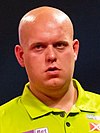
|
Michael van Gerwen (* 1989) | Mighty Mike |
|
PDC world champion 2014, 2017, 2019; PDC vice world champion 2013, 2020 youngest player in darts history to win both a BDO and a PDC tournament |
£ 1,606,750 |
| 2 |

|
Peter Wright (* 1970) | Snakebite |
|
PDC World Champion 2020; PDC Vice World Champion 2014 | £ 944,500 |
| 3 |

|
Gerwyn Price (* 1985) | The iceman |
|
£ 762,250 | |
| 4th |

|
Rob Cross (* 1990) | Voltage |
|
PDC world champion 2018 | £ 594,750 |
| 5 |

|
Michael Smith (* 1990) | Bully boy |
|
PDC Vice World Champion 2019 | £ 572,000 |
| 6th |

|
Gary Anderson (* 1970) | The Flying Scotsman |
|
PDC World Champion 2015, 2016; PDC Vice World Champion 2011, 2017 | £ 531,500 |
| 7th |

|
Daryl Gurney (* 1986) | Great Chin |
|
£ 469,750 | |
| 8th | Nathan Aspinall (* 1991) | The Asp |
|
£ 450,250 | ||
| 9 |

|
James Wade (born 1983) | The Machine |
|
£ 446,750 | |
| 10 | Dave Chisnall (* 1980) | Chizzy |
|
£ 403,750 |
More players
| photo | Surname | Nickname | nation | annotation |
|---|---|---|---|---|
| Martin Adams (born 1956) | Wolfie |
|
BDO world champion 2007, 2010, 2011 | |
| Bob Anderson (born 1947) | The Limestone Cowboy |
|
BDO World Champion 1988 | |

|
Ronnie Baxter (born 1961) | The Rocket |
|
|

|
Steve Beaton (* 1964) | The Bronzed Adonis / Magnum |
|
BDO World Champion 1996 |

|
Eric Bristow (1957-2018) | Crafty Cockney |
|
BDO world champion 1980, 1981, 1984–1986 |
| Richie Burnett (* 1967) | The Prince of Wales |
|
BDO World Champion 1995 | |
| Stephen Bunting (* 1985) | The Bullet |
|
BDO World Champion 2014 | |
| Keith Deller (* 1959) | The Feller |
|
BDO world champion 1983 | |
| Mark Dudbridge (* 1973) | The Flash |
|
||
| Glen Durrant (born 1970) | Duzza |
|
BDO world champion 2017–2019 | |
| Andy Fordham (born 1962) | The Viking |
|
BDO World Champion 2004 | |
| Trina Gulliver (* 1969) | Golden girl |
|
BDO world champion 2001-2007, 2010, 2011, 2016 | |
| Ted Hankey (* 1968) | The Count |
|
BDO World Champion 2000, 2009 | |
| Max Hopp (* 1996) | Maximiser |
|
PDC Junior World Champion 2015 | |
| Jelle Klaasen (* 1984) | The Cobra |
|
BDO World Champion 2006 (youngest world champion so far) | |
| Andreas Kröckel (* 1965) | Andy |
|
German record international player | |
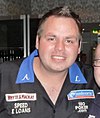
|
Adrian Lewis (* 1985) | jackpot |
|
PDC world champion 2011, 2012 |
| Colin Lloyd (* 1973) | Jaws |
|
||

|
John Lowe (born 1945) | Old Stoneface |
|
BDO World Champion 1979, 1987, 1993 (was the first player to win world titles in three decades) |

|
Peter Manley (born 1962) | One dart |
|
|

|
Wayne Mardle (* 1973) | Hawaii 501 |
|
|
| Kevin Münch (* 1988) | The Dragon |
|
||
| Kevin Painter (born 1967) | The Artist |
|
||
| John Part (born 1966) | Darth Maple |
|
BDO World Champion 1994; PDC world champion 2003, 2008 | |
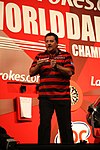
|
Dennis Priestley (* 1950) | The Menace |
|
BDO World Champion 1991; PDC world champion 1994 |
| Leighton Rees (1940-2003) | Marathon Man |
|
BDO World Champion 1978 (first world champion) | |
| Tomas Seyler (* 1974) | Shorty |
|
German champion 2001, 2003, 2004 | |
| Roland Scholten (* 1965) | The tripod |
|
||
| Mensur Suljović (* 1972) | The Gentle |
|
multiple e-darts world champion | |

|
Phil Taylor (* 1960) | The Power |
|
BDO World Champion 1990, 1992; PDC World Champion 1995–2002, 2004–2006, 2009, 2010, 2013 (the second player to win the world title in three decades) |

|
Robert Thornton (* 1967) | The Thorn |
|
|
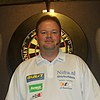
|
Raymond van Barneveld (* 1967) | Barney |
|
BDO World Champion 1998, 1999, 2003, 2005; PDC world champion 2007 |
| John Walton (born 1961) | John Boy |
|
BDO World Champion 2001 | |

|
Mark Webster (* 1983) | The Spider |
|
BDO World Champion 2008 |
| Andree Welge (* 1972) | Raquel |
|
German champion 2002, 2008 | |

|
Simon Whitlock (* 1969) | The Wizard |
|
PDC Vice World Champion 2010 |
| Jocky Wilson (1950-2012) | Jocky |
|
BDO World Champion 1982, 1989 |
literature
- Elmar Paulke: Darts. The earth - one disc. 1st edition. Bombus-Verlag, 2011, ISBN 978-3-936261-69-1 .
- Richard W. von Romatowski Sohlbach: Darts: Technique - Training - Methodology. 5th edition 2017, Meyer & Meyer-Verlag, ISBN 3-89899-386-8 .
- Richard W. von Romatowski Sohlbach: Electronic Darts. Meyer & Meyer-Verlag, 2002, ISBN 3-89124-906-3 .
- Richard W. von Romatowski Sohlbach: Playful learning with darts. Meyer & Meyer-Verlag, 2003, ISBN 3-89124-907-1 .
- Richard W. von Romatowski Sohlbach: 150 darts games. Meyer & Meyer-Verlag, 2002, ISBN 3-89124-857-1 .
- Marcus Rosenstein: Darts. Concentration and precision in the game. 11th edition. Verlag Wolfgang Weinmann, (January) 2011, ISBN 3-87892-048-2 .
- Keith Turner: Darts. The complete book of the game. (= 1st Perennial Library edition. ) Harper & Row, New York 1985, ISBN 0-06-097006-5 .
- Stefan S. Rizzo: Starting with darts. The manual for beginners and hobby players. Book on Demand, Norderstedt 2019, ISBN 978-3-7494-8511-6 .
Web links
- Link catalog on darts at curlie.org (formerly DMOZ )
- Game and tournament regulations (German / French)
- Film about the Bulls Dart German Open, the largest darts tournament in Germany
- PDC website
- Advances in Olympic Darts Approval
Individual evidence
- ^ Keith Turner: Darts - the complete book of the game. Harper Perennial 1985, ISBN 0-06-097006-5 .
- ↑ Image of the Plumbata
- ↑ Arnd Krüger : The sport before the "English sport" in England and on the continent (p. 36-54). Christian Becker, Cornelia Regin , Anton Weise (eds.): When sport came to Hanover. History and reception of a cultural transfer between England and Northern Germany from the 18th to the 20th century . Münster2015, LIT, ISBN 978-3-643-13152-2
- ↑ DSAB announces change in distance from 2016
- ↑ a b Sports and Competition Rules of the German Darts Association (as of October 2019)
- ↑ Table with the most important darts rules (as of January 10, 2019)
- ↑ Checkout table with 3-dart and 2-dart finish
